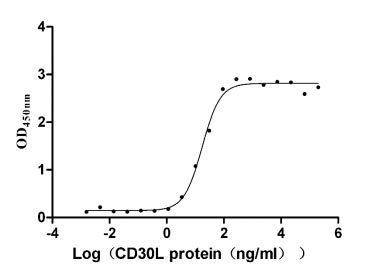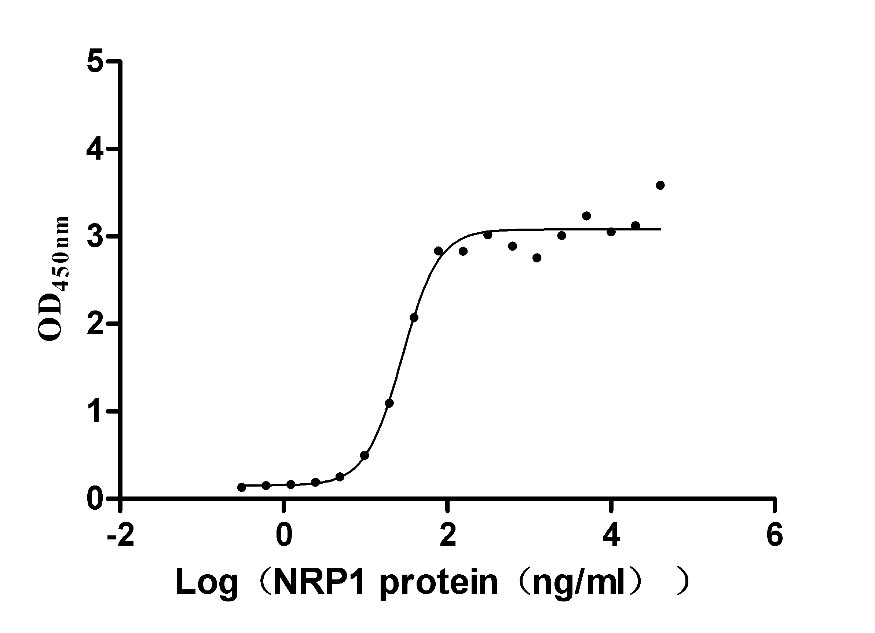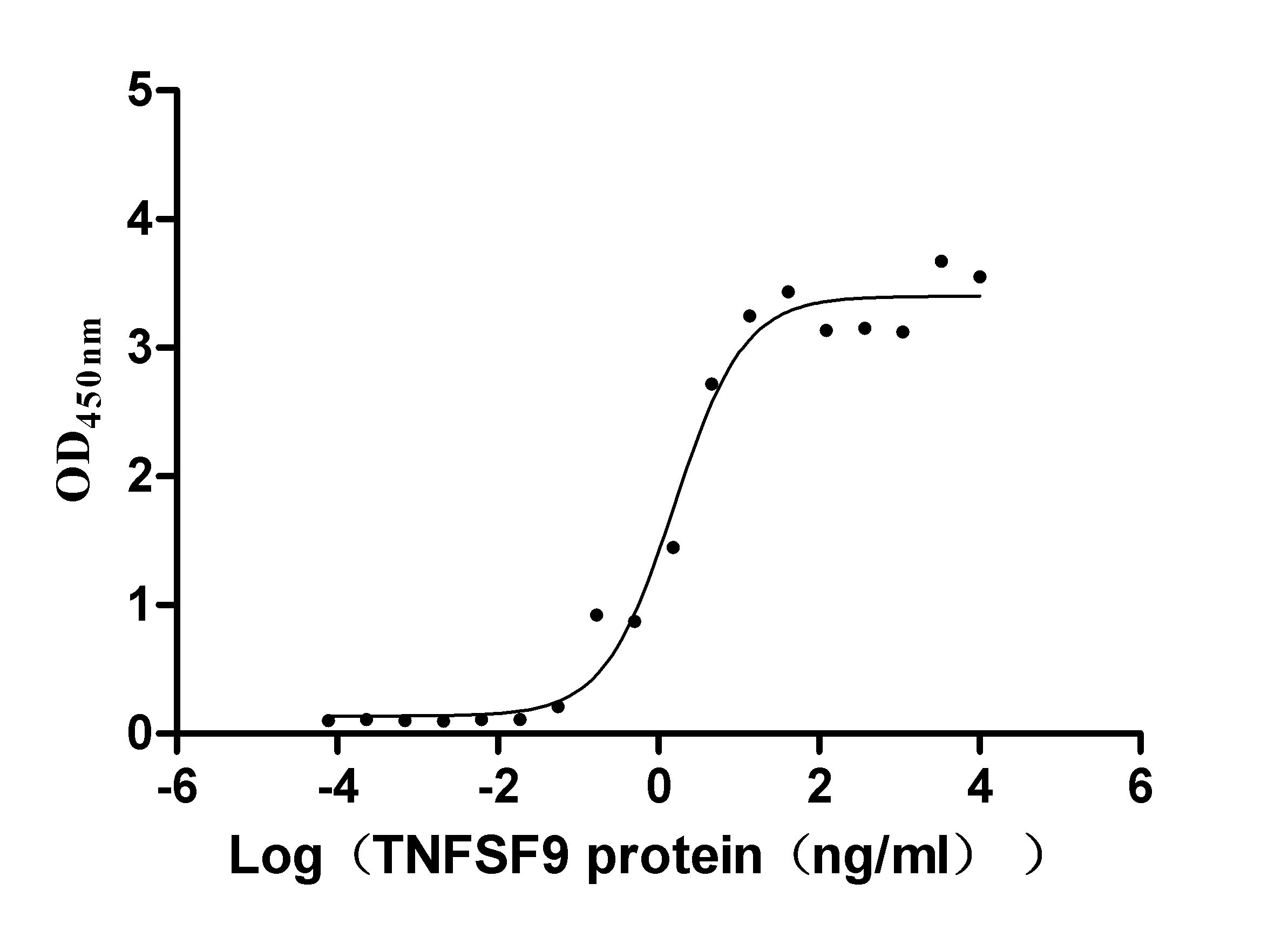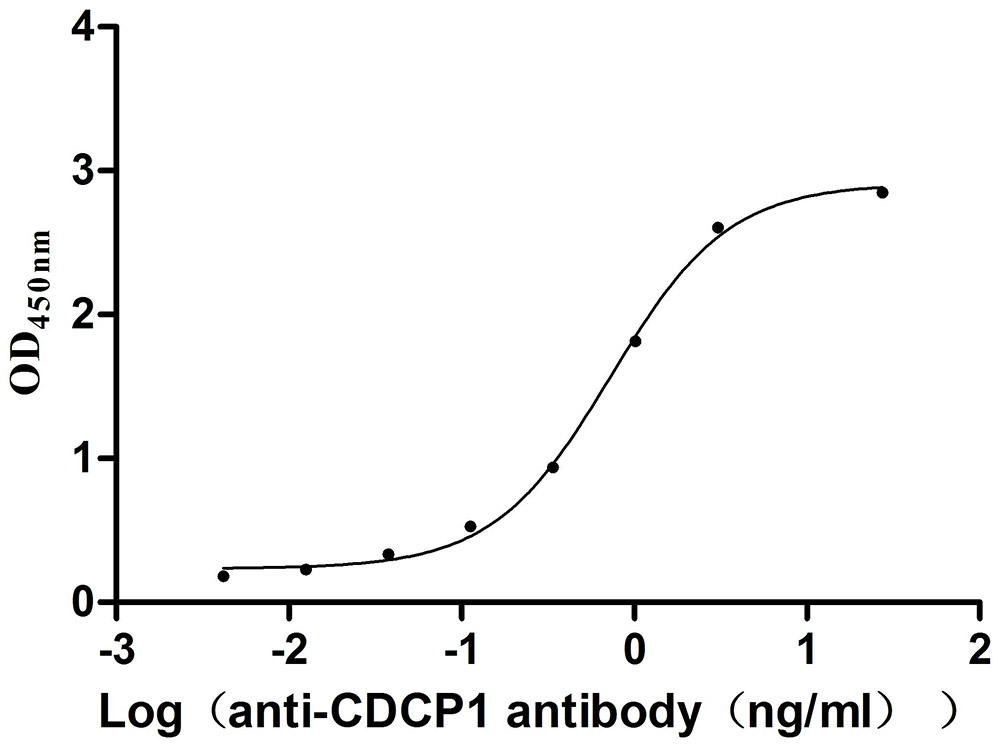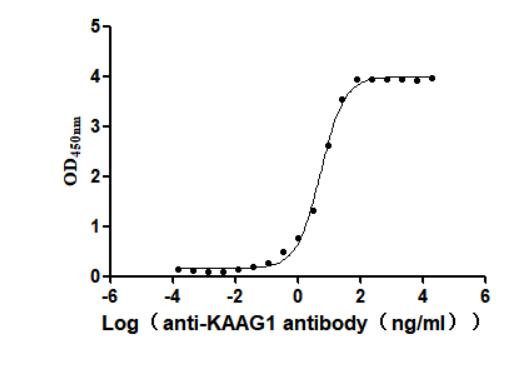Recombinant Human Plasminogen activator inhibitor 1 (SERPINE1)
-
货号:CSB-YP021081HU
-
规格:
-
来源:Yeast
-
其他:
-
货号:CSB-EP021081HU
-
规格:
-
来源:E.coli
-
其他:
-
货号:CSB-EP021081HU-B
-
规格:
-
来源:E.coli
-
共轭:Avi-tag Biotinylated
E. coli biotin ligase (BirA) is highly specific in covalently attaching biotin to the 15 amino acid AviTag peptide. This recombinant protein was biotinylated in vivo by AviTag-BirA technology, which method is BriA catalyzes amide linkage between the biotin and the specific lysine of the AviTag.
-
其他:
-
货号:CSB-BP021081HU
-
规格:
-
来源:Baculovirus
-
其他:
-
货号:CSB-MP021081HU
-
规格:
-
来源:Mammalian cell
-
其他:
产品详情
-
纯度:>85% (SDS-PAGE)
-
基因名:
-
Uniprot No.:
-
别名:Clade E; Endothelial plasminogen activator inhibitor; Nexin ; Nexin plasminogen activator inhibitor type 1; PAI 1; PAI; PAI-1; PAI1_HUMAN; PLANH1; Plasminogen activator inhibitor 1; Plasminogen activator inhibitor type 1; Serine (or cysteine) proteinase inhibitor ; Serine (or cysteine) proteinase inhibitor clade E (nexin plasminogen activator inhibitor type 1) member 1; Serine proteinase inhibitor clade E member 1; serpin; Serpin E1; Serpin peptidase inhibitor clade E (nexin plasminogen activator inhibitor type 1) member 1; Serpin peptidase inhibitor clade E; Serpine 1; SERPINE1
-
种属:Homo sapiens (Human)
-
蛋白长度:Full Length of Mature Protein
-
表达区域:24-402
-
氨基酸序列VHHPPSY VAHLASDFGV RVFQQVAQAS KDRNVVFSPY GVASVLAMLQ LTTGGETQQQ IQAAMGFKID DKGMAPALRH LYKELMGPWN KDEISTTDAI FVQRDLKLVQ GFMPHFFRLF RSTVKQVDFS EVERARFIIN DWVKTHTKGM ISNLLGKGAV DQLTRLVLVN ALYFNGQWKT PFPDSSTHRR LFHKSDGSTV SVPMMAQTNK FNYTEFTTPD GHYYDILELP YHGDTLSMFI AAPYEKEVPL SALTNILSAQ LISHWKGNMT RLPRLLVLPK FSLETEVDLR KPLENLGMTD MFRQFQADFT SLSDQEPLHV AQALQKVKIE VNESGTVASS STAVIVSARM APEEIIMDRP FLFVVRHNPT GTVLFMGQVM EP
-
蛋白标签:Tag type will be determined during the manufacturing process.
The tag type will be determined during production process. If you have specified tag type, please tell us and we will develop the specified tag preferentially. -
产品提供形式:Lyophilized powder
Note: We will preferentially ship the format that we have in stock, however, if you have any special requirement for the format, please remark your requirement when placing the order, we will prepare according to your demand. -
复溶:We recommend that this vial be briefly centrifuged prior to opening to bring the contents to the bottom. Please reconstitute protein in deionized sterile water to a concentration of 0.1-1.0 mg/mL.We recommend to add 5-50% of glycerol (final concentration) and aliquot for long-term storage at -20℃/-80℃. Our default final concentration of glycerol is 50%. Customers could use it as reference.
-
储存条件:Store at -20°C/-80°C upon receipt, aliquoting is necessary for mutiple use. Avoid repeated freeze-thaw cycles.
-
保质期:The shelf life is related to many factors, storage state, buffer ingredients, storage temperature and the stability of the protein itself.
Generally, the shelf life of liquid form is 6 months at -20°C/-80°C. The shelf life of lyophilized form is 12 months at -20°C/-80°C. -
货期:Delivery time may differ from different purchasing way or location, please kindly consult your local distributors for specific delivery time.Note: All of our proteins are default shipped with normal blue ice packs, if you request to ship with dry ice, please communicate with us in advance and extra fees will be charged.
-
注意事项:Repeated freezing and thawing is not recommended. Store working aliquots at 4°C for up to one week.
-
Datasheet :Please contact us to get it.
相关产品
靶点详情
-
功能:Serine protease inhibitor. Inhibits TMPRSS7. Is a primary inhibitor of tissue-type plasminogen activator (PLAT) and urokinase-type plasminogen activator (PLAU). As PLAT inhibitor, it is required for fibrinolysis down-regulation and is responsible for the controlled degradation of blood clots. As PLAU inhibitor, it is involved in the regulation of cell adhesion and spreading. Acts as a regulator of cell migration, independently of its role as protease inhibitor. It is required for stimulation of keratinocyte migration during cutaneous injury repa...显示更多
-
基因功能参考文献:
- results of study have not shown that individual genetic variation in PAI-1 is an independent variable that predispose same of children for renal scarring after first febrile urinary tract infection PMID: 29736094
- upregulation of PAI-1 may be a critical mechanism underlying insufficient neurotrophic support and increased neurodegeneration associated with AD. Thus, targeting BDNF maturation through pharmacological inhibition of PAI-1 might become a potential treatment for AD. PMID: 28132883
- CCL5, from endothelial cells, acts in a paracrine fashion on triple-negative breast cancer (TNBC) cells to enhance their migration, invasion, and metastasis. CCL5, in turn, accelerates TNBC cell secretion of PAI-1 and promotes TNBC cell metastasis, thus forming a positive feedback loop. Moreover, this enhanced metastatic ability is reversible and dependent on CCL5 signaling via the chemokine receptor, CCR5. PMID: 28899878
- The present study shows that mean serum TSH and PAI-1 levels were higher in MetS cases as compared to healthy controls and even higher in MetS cases with SCH as compared to MetS cases without SCH. Thus, it can be summarized that in MetS with the presence of thyroid dysfunction, adipocytes behave abnormally and secrete various adipokines such as PAI-1 which in future may lead to thrombotic complication PMID: 29261514
- Protease nexin-1 prevents growth of human B cell lymphoma via inhibition of sonic hedgehog signaling. PMID: 29483508
- PAI-1 gene polymorphisms have roles in atherosclerotic diseases [review] PMID: 29908999
- Decreased fibrinolytic activity increased, whereas PAI-1 4G/5G polymorphism did not influence venous thrombosis risk in this study. PMID: 28777103
- The G-4G-C/A-5G-G PAI-1 haplogenotype may be a genetic marker of susceptibility for obesity and hypertriglyceridemia in Mexican children PMID: 29938477
- The analysis of genotype coexistence revealed a higher incidence of the combination of the ACE II and the PAI-1 4G/4G genotypes in the control group (10.0 vs.5.9% in control group; p = 0.17). CONCLUSIONS: The obtained results suggest no apparent association between the ACE I/D, PAI-1 4G/5G polymorphisms and increased RM susceptibility in the analyzed Polish population. PMID: 27321098
- Serum PAI-1 level at the time of traumatic brain injury may serve as a predictive biomarker of late pituitary dysfunction in mild traumatic brain injury patients. PMID: 28931364
- The personalization of the patients' treatment using uPA/PAI-1 tumor levels allows the reversion of the well-known poor prognostic impact of high uPA/PAI-1 levels and strongly supports the use of this biomarker in clinical practice. PMID: 28685212
- Data show that plasminogen activator inhibitor-1 (PAI-1) and chemokine CCL5 (CCL5) overexpression promoted cell proliferation and migration in breast cancer cells. PMID: 29601121
- Multiple sclerosis patients were categorized as not cognitively impaired (NCI) and cognitively impaired (CI). The NCI group had a higher percentage of heterozygous subjects but no statistical differences were found between the CI and NCI group. Neuropsychological functioning did not correlate with plasma levels of PAI-1 or its genetic polymorphism. PAI-1 plasma levels were related to neurological impairment. PMID: 29111023
- Results demonstrated that EMT could promote the secretion of PAI-1 in the triple negative breast cancer (TNBC) cells. TNBC-secreted PAI-1 could increase cell growth, migration and invasion, and the expression of EMT markers in the TNBC cell lines and xenograft mice model. Most importantly, PAI-1 expression is significantly elevated in the breast cancer tissues and associated with prognosis of patients with TNBC. PMID: 29802992
- Plasma PAI-1 levels may be determined by the degree of obesity and triglyceride metabolic disorders. These factors correlate with a decreased LDL-particle size, increasing the risk of atherosclerosis. PMID: 28692480
- In this meta-analysis, it was determined that PAI-1 polymorphism confers a genetic contribution to the development of recurrent spontaneous abortion. PMID: 28395596
- The A allele and AA genotype of rs6092 in SERPINE 1 may protect against T2 diabetes, and have a protective effect on waist circumference, but a negative effect on Triglycerides in men, while may contribute to a lower HbA1c level in women. PMID: 29627522
- Adjuvant chemotherapy was 9% less likely to be recommended by a multidisciplinary board when using the current criteria compared with using a combination of the St. Gallen criteria and Ki67 and uPA/PAI-1 status (P = 0.03). Taken together, our data show discordance among markers in identifying the risk of recurrence, even though each marker may prove to be independently valid. PMID: 28954632
- Study shows that hyperglycaemia-induced repression of miR-30c increases PAI-1 expression and thrombus formation in type 2 diabetic mellitus. PMID: 27819307
- human plasma protects against endothelial cell apoptosis through sustained BAD phosphorylation, which is achieved by, at least in part, a novel interaction between PP1 with PAI1. PMID: 28296156
- Statistically significant association was not found between 4G/4G genotype and CVT risk. PAI-1 4G/4G is a strong risk factor for venous thrombosis in Indian patients and should be included in laboratory testing panel of thrombophil. PMID: 28561456
- PAI-1 -675 4G/5G polymorphism was not associated with type 2 diabetes mellitus risk in this population. PMID: 28838342
- the association of a gain-of-function polymorphism in the PAI-1 promoter region, rs2227631, with lung function is modified by asthma status. The polymorphism is associated with decreased FEV1/FVC ratio and increased prevalence of airway obstruction in Latino and African American subjects with asthma, but it has no effect in healthy controls. PMID: 28543872
- Plasminogen activator inhibitor-1 has a role in determining leukocyte telomere length in American Indians PMID: 28378522
- we have identified a detailed molecular mechanism in which p53 acts in partnership with Smad to selectively enhance PAI-1 transcription. PMID: 27759037
- PAI-1 is implicated in the pathophysiology of depression. PMID: 27456456
- Plasminogen activator inhibitor 1 (PAI-1) is associated with the risk of Alzheimer's disease (AD) in Tunisian patients. PMID: 28466654
- PAI-1 levels are increased in patients with recurrent pregnancy losses (RPL), preeclampsia, intrauterine growth restriction (IUGR), gestational diabetes mellitus (GDM) in the previous pregnancy, endometriosis and polycystic ovary syndrome (PCOS). In general, an increased expression of PAI-1 in the blood is associated with an increased risk for infertility and a worse pregnancy outcome. PMID: 28758928
- PAI-1/tPA ratio may be an important parameter to monitor the progression of OSMF, and normalizing this ratio to 1:1 may reinstate the normal healing pattern in OSMF cases PMID: 27212010
- uPA, uPAR, and PAI-1 expression was up-regulated in the epidermis of psoriatic skin and in tumor cells in basal cell carcinomas. PMID: 28429105
- evidence for the significant association of PAI-1 4G/5G polymorphism with an increased risk of adult but not pediatric ischemic stroke (Meta-Analysis) PMID: 26742513
- Review/Meta-analysis: indicates a causal effect of elevated PAI-1 level on coronary heart disease risk, which may be mediated by glucose dysfunction. PMID: 28550093
- Case Report: mutation in a highly conserved glycine residue in strand 5B of plasminogen activator inhibitor 1 causes polymerization and PAI-1 deficiency. PMID: 28229167
- PAI-1 and TGF-beta1 promote non-small cell lung cancer tumor cells and tumor-associated macrophages and might be valuable targets for cancer immunosuppression. PMID: 29253845
- This study suggests that PAI-1 is an independent predictor of impaired insulin sensitivity among chronic HIV-infected individuals. PMID: 28322572
- Our study suggested that SERPINE1 may be a promising therapeutic target for chemoresistance. PMID: 28975405
- PAI-1 mRNA expression is significantly increased in cutaneous lesions of patients with livedoid vasculopathy lesions. PMID: 28186689
- We show that the tumor-suppressive actions of MEPs are mediated by PAI-1, uPA and its receptor, uPAR, and are sustained even in the presence of the CAFs, which themselves enhance DCIS tumorigenesis via IL-6 signaling. PMID: 28506312
- The concentration of tPA/PAI-1 complex is an independent predictor of mortality from all causes and from cardiovascular causes in patients with heart failure and preserved ejection fraction. PMID: 27975104
- tPA:Ag and PAI-1:Ag concentration analysis in diabetic foot syndrome depending on age, gender and BMI did not show any significant differences PMID: 28193577
- The homozygous variant 4G/4G also was found to be associated with the higher PAI-1 levels (0.005). The variant allele 4G of PAI-1 4G/5G polymorphism and higher plasma PAI-1 levels were found to be significantly associated with IS in young Asian Indians. PMID: 28460568
- uPA/uPAR and SERPINE1 have roles in in head and neck cancer tumor resistance, metastasis, prognosis and therapy [review] PMID: 27385000
- High PAI-1 expression is associated radioresistance and aggressiveness of non-small cell lung cancer. PMID: 27004408
- The PAI-1 4G/5G genotype was not a relevant predictor of persistent residual venous occlusion after idiopathic deep vein thrombosis, which however was associated with age. PMID: 28347810
- data suggest that even an isocaloric exchange of macronutrients - for example, a switch to a fat-rich diet - affects PAI-1 concentrations in humans and that this is highly heritable. PMID: 28633683
- The current study revealed a significant increase level of TAFI and PAI-1, coupled with a decrease in PAI-2 in women with severe preeclampsia in comparison with the control group. PMID: 27598010
- The abundance of free PAI-1 and TAFI in the plaque may inhibit plasmin generation and thereby counteract plaque destabilization by fibrinolysis, cell migration and inflammation PMID: 28135035
- Genotype PAI 4G/4G is significantly more common in patients with allergic rhinitis (28.1% vs. 16.1%; P = 0.017) compared to the genotype 5G/5G. The results suggest that the carriers of at least one 4G allele are at a higher risk for developing symptoms of allergic rhinitis in asthma. PMID: 28258374
- Genetic polymorphism in the promoter region of the PAI-1 gene was associated with early onset coronary artery disease. PMID: 27805237
- MetS prevalence in the Ghanaian population studied was comparable to that of the industrialized West. PAI-1 may serve as a key link between MetS, as currently defined, and the endpoints with which it is associated. PMID: 27697752
收起更多
-
相关疾病:Plasminogen activator inhibitor-1 deficiency (PAI-1D)
-
亚细胞定位:Secreted.
-
蛋白家族:Serpin family
-
组织特异性:Expressed in endothelial cells. Found in plasma, platelets, and hepatoma and fibrosarcoma cells.
-
数据库链接:
HGNC: 8583
OMIM: 173360
KEGG: hsa:5054
STRING: 9606.ENSP00000223095
UniGene: Hs.414795


